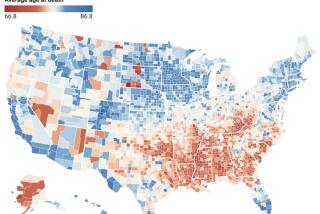We Can Live Far Longer, Study Says
Humans are far from a limit on life expectancy, if one even exists, according to a new statistical analysis of increases in longevity.
The finding challenges the widespread assumption that life expectancy, which increased rapidly in the United States and other countries during the 20th century, will level off close to current records, said James Vaupel, lead author and director of the Max Planck Institute for Demographic Research in Rostock, Germany.
“I think there must be a limit out there, somewhere, but we’re nowhere near it,” added Jim Oeppen, a co-author of the study and a demographer with the Cambridge Group for the History of Population and Social Structure in England.
The two researchers compared the countries that held the record for longest life expectancies for women: New Zealand until 1950, Norway until the 1980s and Japan until the present.
In each case, they found, the life expectancy of women in the country holding the record increased by three months per year. The rate of increase has been steady for the last 160 years and shows no sign of slowing, they found. For men, the increase was smaller--just under three months--but just as steady. The research is published in today’s issue of Science.
Vaupel said people have always assumed there is a limit to life span.
“You can trace it right back to the Bible, three score and 10 years,” he said.
Other researchers have predicted that life expectancy would continue to rise but at a decreasing rate. The new work, however, indicates that life expectancy increases should remain steady into the future.
“The increase in record life expectancy has been so linear it’s likely to continue,” Vaupel said.
Ronald Lee, professor of demographics at UC Berkeley and an advisor to the Social Security Administration, described the trend as “striking.”
“This is going to force me to change how I look at things somewhat,” he said.
Others, however, disputed the findings.
“It’s regularity only within a very limited time frame,” said Jay Olshansky, professor at the School of Public Health at the University of Chicago in Illinois.
“They have chosen the period of time in the past 130,000 years during which life expectancy rose the fastest (i.e., the 20th century), and simply extended that trend indefinitely into the future,” Olshansky said in an e-mail response to questions about the study.
From Roman times until 1850, life expectancy hovered around 40 to 45 years, he said. And as life expectancy increases it becomes more difficult to increase it further.
“It is a far different ballgame going from 80 to 83 than 50 to 53,” Olshansky said.
Vaupel’s model does not take into account the various biochemical, biomechanical and demographic forces that affect life expectancy, Olshansky added.
“They have used mathematics and statistics to look at a phenomenon that is inherently biological,” he said. “All they are looking at is the mathematics of the phenomenon. They are completely ignoring the biology.”
To calculate life expectancy, actuaries and demographers use mathematical models of death rates at different ages to predict how long people born in a specific year can be expected to live. For average life expectancy to increase to 100, more than half the population would have to live beyond that age.
Many scientists have proposed maximum limits on human life expectancy in the last 80 years. Some populations usually exceeded these caps on human life expectancy within five years of the limit’s announcement, Vaupel said.
Vaupel and Oeppen said that what some researchers have observed as a leveling of life expectancies is really a game of catch-up. Some countries experience rapid increases as they approach the life expectancy of the country in the lead and the leaders fall behind.
During the first half of the 20th century, advances in the treatment of infectious diseases increased the number of young people who survived to old age, increasing life expectancy. But the three-month increase continued in the latter half of the century as well, with improvements in life expectancy for people older than 65. This age group typically died of chronic diseases such as cancer.
“The spectrum of diseases people died from shifted dramatically, but nevertheless every year on average about three months is added to life expectancy,” Vaupel said. “The diseases have changed but the general pace of progress has stayed the same.”






